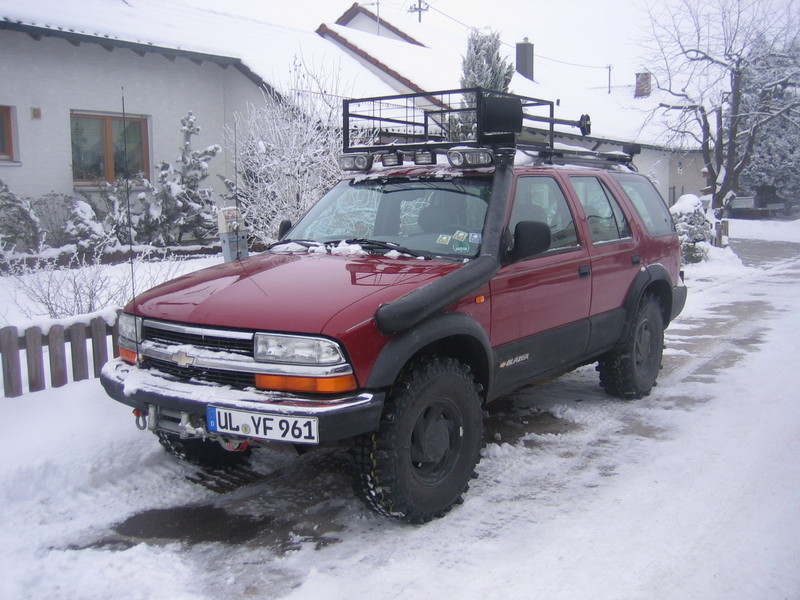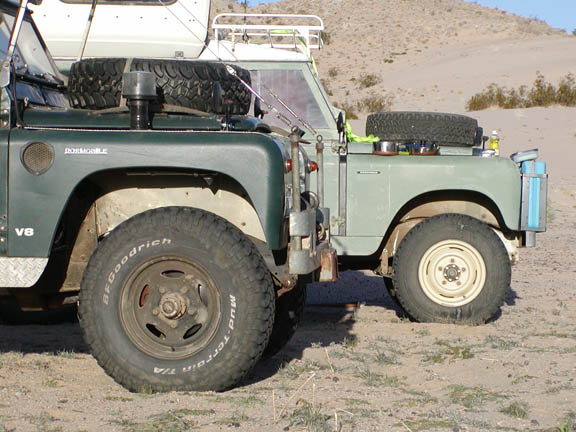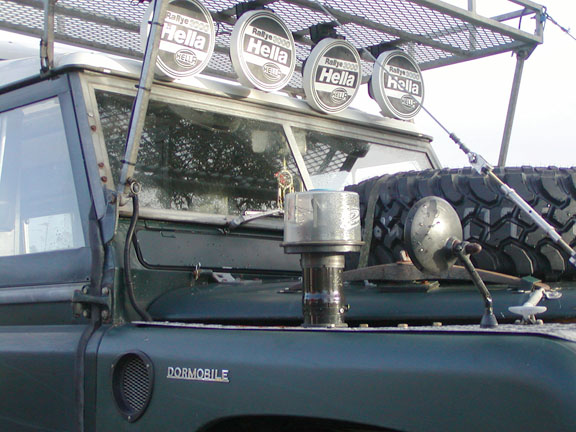Evolution
Once upon a time I decided it would be ever so cool to have a snorkel on my truck just like the fully prepped Camel Trophy Land Rovers. So I went out and bought the same brand snorkel that they used.
I thought it was ever so cool and it provided cleaner air from the top of the truck so I would not have to change the oil in my oil bath air filter as often.
I was very careful to keep the snorkel inside the stock vehicle width with no part of it sticking out to the side. I was driving a lot of heavily overgrown trails where sticky outies were often removed without notice as you navigate the trail.
The snorkel didn't increase my wading depth. It was limited by the height of the engine distributor since I am driving a petrol Land Rover. If I'd had a diesel with mechanical injection a snorkel would have made a difference in wading depth. But a Series Land Rover's stock air filter intakes from the highest point inside the bonnet well above the distributor. And generators/alternators don't preform at their best when submerged.
So the bottom line was that it looked ever so "expedition" cool, provided cleaner air to a filter already very good at removing dirt from the air, and not needing frequent servicing. Oh, and it was the subject of many a parking lot conversation.
Come the Summer of 1999 and I converted to a larger engine. Being a good little girl who believes in studying up on things, I learned that engines are largely just air pumps. The more efficiently they can draw in air and remove the exhaust, the more power a given engine can produce up to the engine's maximum capacity.
So I got to thinking that the long snorkel was like trying to drink out of a long narrow straw and had to be affecting engine efficiency, which affected fuel mileage.
Over the few years I had a snorkel I became more observant of things it was supposed to help protect from.
Yes there was an incredible amount of dust that seems to get kicked up into the engine bay (at least in a Series truck) and around the wheels. But over half of that dust seems to be below wing top level.
Bow waves seem to be mostly that, waves at the bow and unless you were purposefully making a splashy crossing for the cameras or to impress others, bow waves mostly stayed at the bow and about 1/3rd of the way along the front sides of the wings. And again I can only go as deep as my distributor (for newer cars to the level of electronics that do not play well with water immersion).
And, I got a good close look at military Humvee filters. They have diesel power, a good air filter and a prefilter sitting as close to the filter as it can be and still work properly as a prefilter. No long tubes to suck air through.
When it came time for me to come up with a filter for my larger engine, I decided that the military Humvee designers had probably given a lot of thought and testing to their design and that there was a lot of similarities between military Humvee systems and newer commercial earth moving systems used in extreme dust environments.
I had also largely gotten over the need to have the coolest looking "expedition" truck around.
Taking a page from the military Humvee designers, I decided to try for maximum airflow for the engine, efficient filtration, cleaner, cooler air from above the wing top with an intake above the maximum wading level of my truck.
My airflow goal was a minimum of air flow restrictions and air direction bends. For filtration I went where most of the commercial earth mover vehicle designers go, the Donaldson catalogue.
I calculated the airflow of my engine at idle RPM (750), and maximum real life highway cruising RPM (3000 @ 70 MPH) and with these numbers went shopping for an air filter that fit the area I had, was sealed from moisture, provided the shortest and most direct pathways to the mass air unit and engine AND was designed to handle at least the airflow my engine needed with minimal restriction. For me that meant a horizontal canister with a vertical intake at the rear and a horizontal outlet also at the rear.
I also went with a Donaldson prefilter that was carefully chosen to best match my engine air intake requirements for the RPM range I drive in. A prefilter has a maximum and minimum airflow spec for proper operation without becoming restrictive. Donaldson specs a minimum free space of 6 inches around the prefilter intake for proper operation.
So this is what I ended up with:
A Donaldson horizontal canister filter mounted to the underside of the wing top above the front tyre. You can see the bottom of it in the top picture. The outlet of the filter has a short rubber connector tube that connects the filter to the MAF unit and there is a short almost straight tube (about 5 or 6 inches) between the MAF and the throttle body. The pathway from the filter to the engine is as short and straight as I could make it. The filter element can be inspected or replaced from the wheel well without removing the housing body.
The prefilter sits on top of a 6 inch length of exhaust pipe and is a straight shot into the air filter intake. The air only changes direction inside the filter and prefilter. The straw the engine sucks through is as short as I can make it, has a minimal number of air flow restrictions or direction changes and it is carefully spec'ed to match my engine's needs. It doesn't affect my maximum wading depth and the intake air is probably cleaner than what I had going into the engine.
Nowhere near the cool expedition rig look as I had going with the long Camel Trophy style snorkel but way more effective. Somewhere along the way I had decided that function was more important to me than the coolest "look".






